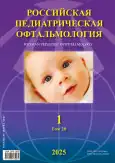Воспалительные заболевания век у детей. Часть I.
- Авторы: Ковалева Л.А.1,2, Балацкая Н.В.1, Кричевская Г.И.1, Байсангурова А.А.1, Кузнецова Т.В.1
-
Учреждения:
- НМИЦ глазных болезней им. Гельмгольца
- Российский университет медицины
- Выпуск: Том 20, № 1 (2025)
- Страницы: 5-13
- Раздел: Оригинальные исследования
- URL: https://journal-vniispk.ru/1993-1859/article/view/293682
- DOI: https://doi.org/10.17816/rpoj656047
- EDN: https://elibrary.ru/MIBHMV
- ID: 293682
Цитировать
Аннотация
Цель. Анализ этиопатогенеза, клинических особенностей и алгоритма терапии воспалительных заболеваний век у детей.
Результаты. Наиболее тяжёлая форма воспалительных заболеваний век — это герпетический блефарит, который во всех случаях осложняется герпетическим кератитом и язвой роговицы, и пальпебральный фтириаз — поражение век лобковыми вшами (Phthirus pubis). Проведён анализ особенностей этиопатогенеза воспалительных заболеваний век у детей, описаны характерные клинические симптомы герпетического блефарита, ассоциированного с первичным инфицированием вирусом простого герпеса 1 типа (HSV 1), ветряной оспой и опоясывающим герпесом (herpes zoster ophthalmicus); а также, клинические симптомы фтириаза век у детей.
Заключение. Описанная в статье клиническая картина офтальмогерпеса способствуют ранней диагностике, что позволяет своевременно начать противовирусную терапию с противогерпетическим эффектом, предупредив развитие хронического течения заболевания, возникновения осложнений, сохранения и/или восстановления остроты зрения.
Полный текст
Открыть статью на сайте журналаОб авторах
Людмила Анатольевна Ковалева
НМИЦ глазных болезней им. Гельмгольца; Российский университет медицины
Email: ulcer.64@mail.ru
ORCID iD: 0000-0001-6239-9553
SPIN-код: 1406-5609
канд. мед. наук
Россия, Москва; МоскваНаталья Владимировна Балацкая
НМИЦ глазных болезней им. Гельмгольца
Автор, ответственный за переписку.
Email: balnat07@rambler.ru
ORCID iD: 0000-0001-8007-6643
SPIN-код: 4912-5709
канд. биол. наук
Россия, МоскваГалина Исааковна Кричевская
НМИЦ глазных болезней им. Гельмгольца
Email: gkri@yandex.ru
ORCID iD: 0000-0001-7052-3294
SPIN-код: 6808-0922
канд. мед. наук
Россия, МоскваАльбина Анатольевна Байсангурова
НМИЦ глазных болезней им. Гельмгольца
Email: alia-bai-5@mail.ru
ORCID iD: 0000-0002-8014-667X
SPIN-код: 2308-0920
врач-офтальмолог
Россия, МоскваТатьяна Владимировна Кузнецова
НМИЦ глазных болезней им. Гельмгольца
Email: tatakuzn@gmail.com
ORCID iD: 0009-0005-1333-2420
SPIN-код: 4815-6968
врач-офтальмолог
Россия, МоскваСписок литературы
- Safonova TN, Kintukhina NP, Sidorov VV. Treatment of chronic blepharitis. Russian Annals of ophthalmology. 2020;136(1):97–102. doi: 10.17116/oftalma202013601197 EDN: YPICZZ
- Nichols KK, Foulks GN, Bron AJ, et al. The international workshop on meibomian gland dysfunction: Executive summary. Invest Ophthalmol Vis Sci. 2011;52(4):1922–1929. doi: 10.1167/iovs.10-6997a
- Putnam CM. Diagnosis and management of blepharitis: An optometrist’s perspective. Clin Optom (Auckl). 2016;8:71–78. doi: 10.2147/OPTO.S84795
- American Academy of Ophthalmology (author), Weisenthal RW, editor. 2017–2018 Basic and Clinical Science Course (BCSC), Section 08: External disease and cornea (Major Revision). American Academy of Ophthalmology; 2017. 533 p.
- Akcinar UG, Unal E, Akpinar M. Demodex spp. infestation associated with treatment-resistant chalazia and folliculitis. Turkiye Parazitol Derg. 2016;40(4):208–210. doi: 10.5152/tpd.2016.4869
- Bezza Benkaouha I, Le Brun C, Pisella PJ, et al. Bacterial flora in blepharitis. J Fr Ophtalmol. 2015;38(8):723–728. (In French). doi: 10.1016/j.jfo.2015.01.012
- Bernardes TF, Bonfioli AA. Blepharitis. Semin Ophthalmol. 2010;25(3):79–83. doi: 10.3109/08820538.2010.488562
- Lindsley K, Matsumura S, Hatef E, Akpek EK. Interventions for chronic blepharitis. Cochrane Database Syst Rev. 2012;2012(5):CD005556. doi: 10.1002/14651858.CD005556.pub2
- O’Gallagher M, Bunce C, Hingorani M, et al. Topical treatments for blepharokeratoconjunctivitis in children. Cochrane Database Syst Rev. 2017;2(2):CD011965. doi: 10.1002/14651858.CD011965.pub2
- Hykin PG, Bron AJ. Age-related morphological changes in lid margin and meibomian gland anatomy. Cornea. 1992;11(4):334–342. doi: 10.1097/00003226-199207000-00012
- Yeotikar NS, Zhu H, Markoulli M, et al. Functional and morphologic changes of meibomian glands in an asymptomatic adult population. Invest Ophthalmol Vis Sci. 2016;57(10):3996–4007. doi: 10.1167/iovs.15-18467
- Wallace DK, Morse CL, Melia M, et al. Pediatric eye evaluations Preferred Practice Pattern®: I. Vision screening in the primary care and community setting; II. Comprehensive ophthalmic examination. Ophthalmology. 2018;125(1):P184–P227. doi: 10.1016/j.ophtha.2017.09.032
- Daniel MC, O’Gallagher M, Hingorani M, et al. Challenges in the management of pediatric blepharokeratoconjunctivis / ocular rosacea. Exp Rev Ophthalmol. 2016;11(4):299–309. doi: 10.1080/17469899.2016.1209408
- Viswalingam M, Rauz S, Morlet N, Dart JK. Blepharokeratoconjunctivitis in children: diagnosis and treatment. Br J Ophthalmol. 2005;89(4):400–403. doi: 10.1136/bjo.2004.052134
- Kovaleva LA, Kuznetsova TV, Baisangurova AA, Zaitseva AA. Clinical features, diagnosis, and treatment of dry eye syndrome in children. Russian pediatric ophthalmology. 2023;18(2):95–104. doi: 10.17816/rpoj321832 EDN: IRZFYD
- Kovaleva LA, Baisangurova AA, Kuznetsova TV, Zaitseva AA. Scleritis in children: Etiology, pathogenesis, clinical features, diagnostic, and treatment algorithm. Russian pediatric ophthalmology. 2023;18(3):119–127. doi: 10.17816/rpoj567972 EDN: APMEOW
- Kovaleva LA, Kuznetsova TV, Baisangurova AA, Zaitseva AA. Current treatment options for dry eye syndrome in children. Russian pediatric ophthalmology. 2024;19(1):15–24. doi: 10.17816/rpoj623620 EDN: RZWNXO
- El-Shazly AA, El-Zawahry WM, Hamdy AM, Ahmed MB. Passive smoking as a risk factor of dry eye in children. J Ophthalmol. 2012;1212:130159. doi: 10.1155/2012/130159
- Kovaleva LA, Balatskaya NV, Krichevskaya GI, Baisangurova AA. Anterior diffuse scleritis, map-like corneal ulcer, and hypopyon anterior uveitis associated with Herpes zoster. Russian pediatric ophthalmology. 2024;19(4):239–247. doi: 10.17816/rpoj641571 EDN: QAQZVE
- Kovaleva LA, Krichevskaya Gi, Davydova GA, Zaitseva AA. Сhronic unilateral anterior nodular scleritis with local inflammation of the ciliary body associated with the Varicella-zoster virus. Russian pediatric ophthalmology. 2022;17(2):31–38. doi: 10.17816/rpoj105641 EDN: HZNBGM
- Dohvoma VA, Mvogo SR, Atangana PJ, et al. Phthirus pubis infestation of the eyelids presenting as chronic blepharoconjunctivitis in a 6-year-old girl: A case report. Case Rep Ophthalmol. 2018;9(1):30–34. doi: 10.1159/000485738
- Lacarrubba F, Micali G. The not-so-naked eye: Phthiriasis palpebrarum. Am J Med. 2013;126(11):960–961. doi: 10.1016/j.amjmed.2013.08.002
Дополнительные файлы





















